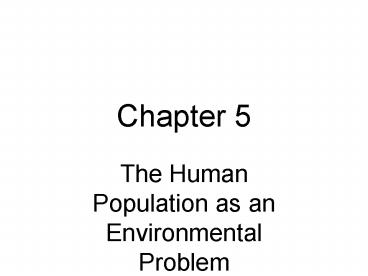The Human Population as an Environmental Problem - PowerPoint PPT Presentation
1 / 23
Title:
The Human Population as an Environmental Problem
Description:
Human impact varies w/lifestyle, this is sometimes called 'ecological footprint' ... Life expectancy - average expected lifespan at birth. 5.2 Key points ... – PowerPoint PPT presentation
Number of Views:171
Avg rating:3.0/5.0
Title: The Human Population as an Environmental Problem
1
Chapter 5
- The Human Population as an Environmental Problem
2
A Few Current NumbersSourcepopulation reference
bureau
- World Population - 6.48 billion
- Percent growth 1.2
- US Population - 297 million
- Percent growth 0.6
3
Most Populous CountriesSourcepopulation
reference bureau
- 1 China - 1.3 billion
- Percent growth 0.6
- 2 India - 1.1 billion
- Percent growth 1.7
- 3 USA - 297 million
- Percent growth 0.6
4
Most Populous CountriesSourcepopulation
reference bureau
- 4 Indonesia - 222 million
- Percent growth 1.6
- 5 Brazil - 184 million
- Percent growth 1.3
- 6 Pakistan - 162 million
- Percent growth 2.4
5
A Few Current TrendsSourcepopulation reference
bureau
- More developed countries - 1.2 billion
- Percent growth 0.1
- Less developed countries - 5.3 billion
- Percent growth 1.5 (1.8 w/out china)
6
Effect of technology (1)
- Impact of humans depends on two factors the
number of humans, and the impact of each - Human impact varies w/lifestyle, this is
sometimes called ecological footprint
7
Effect of technology (2)
- Technology allows us to overcome (temporarily)
Malthus prophecy - Buttechnology increases our impact and adds
additional types of impact
8
Malthus Prophecy
- Food is necessary for people to survive
- People will continue to reproduce
- Population growth will outpower agricultural
growth
9
Considering Numbers
- World Population 6.4 billion
- Area of Texas 261,797 sqft
- Put every person on earth in Texas and they each
get 1140 sqft or 38 people per acre - BUT.
10
More on Ecological Footprint
- In USA each person requires 10.4 hectares for
resources - In Bangladesh each person requires 0.5 hectares
for resources - World 2.8 hectares (only 2.1 available)
- SourceIPCC
11
Ecological Footprint bottom line
- Less populous nations may have greater
environmental impact than more populous
countries. - See pg 78
12
5.1 Key Points
- Earth is at 6.5 and growing at 1.2
- Developing countries have both higher numbers and
higher growth rates than developed countries - Human impact is a product of the number of humans
and the impact of each
13
5.1 Key Points (cont)
- Technology increases number of humans and can
change type of impact - Malthus made key points about carrying capacity
and MUST ultimately be right
14
Key Population concepts
- Age structure
- Demographic Transition
- Fertility
- Human population v. environment
- Deathrate increase
- Standard of living and pop factors
15
History of Human Pop.
- I - Hunter Gatherer, a few mil.
- II - Rise of agriculture, allowed density
increase - III - Industrial revolution, rapid increase
- IV - Present, slow in ind, but fast in devel.
16
Population factors
- g b - d (growth births - deaths)
- Crude rates per 1000
- Percent rate per 100
- So, 9 births per 1000 crude rate 0.9 birth
rate
17
Important terms
- Maximum lifetime - genetically determined
potential - Life expectancy - average expected lifespan at
birth
18
5.2 Key points
- As technology changed human lifestyle, patterns
of pop growth changed - g b - d
- Key terms ie crude growth rate, max lifetime,
etc
19
A note on book numbers
- Trends IDed on p. 83 - 84
- But, according to pop data sheet no countries are
growing at 5, a few are at 3.5 (highest listed)
20
Logistic Growth Curve
21
Why Logistic is limited
- Three assumptions
- Constant environment
- Constant carrying capacity
- Homogeneous population
- Especially unreliable if technology changes death
rates
22
Predicting Human Population
- Using logistic growth for this requires an
inflection point - BUThumans have not reached a clear inflection
point - 3 UN projections are on page 85
23
The Demographic Transition































